|
 Bolbitius vitellinus Bolbitius vitellinus
SynonymsAgaricus vitellinus
BiostatusPresent in region - Exotic
Images (click to enlarge)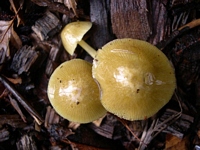
Caption: from wood chip mulch
Owner: B. Dee | 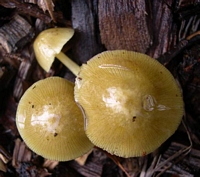
Owner: B. Dee | 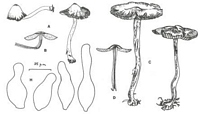
Caption: A-B Taylor 313, A. Basidiomata with section (B); C-D & H Taylor 570, C. Basidiomata with section (D); H. Cheilocystidia. | 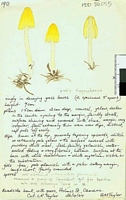
Caption: Watercolour
Owner: G.M. Taylor | 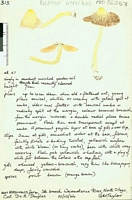
Caption: Watercolour
Owner: G.M. Taylor | 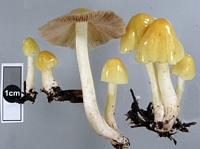
Owner: J.A. Cooper | 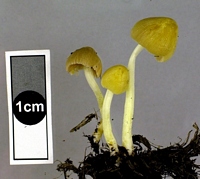
Owner: J.A. Cooper | 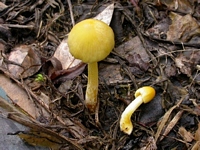
Caption: fruitbodies
Owner: J.A. Cooper | 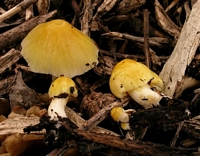
Owner: J.A. Cooper |
Article: Watling, R.; Taylor, G.M. (1987). Observations on the Bolbitiaceae: 27. Preliminary account of the Bolbitiaceae of New Zealand. Bibliotheca Mycologica 117: 61 p. + 17 pl.
Description: Description of New Zealand collections:-
Pileus conical (15-30 mm), rapidly becoming plano-convex or plane (15-60 mm), with or without an umbo, bright yellow (yellow - chrome) darker at the disc, paler towards the margin where it becomes cinnamon-brown, shining, glutinous, finally fawn throughout except for yellow centre; margin striate, splitting and partially collapsing. Stipe 70-110 x 2-3 mm, tapering upwards, sometimes somewhat wider at the base, whitish or extremely pale yellow, pruinose or farinaceous throughout becoming white-silky, stuffed. Gills free or adnexed, pale yellowish with paler watery margin, becoming fawn, finally red-brown, fairly crowded, very thin and papery. Flesh very thin, distinction between pileus and stipe obvious, whitish or pale yellowish.
Basidiospores 11.5-14 x 7-8.5 µm, ellipsoid, thick-walled, sienna in water more strongly pigmented in aqueous alkali solutions, smooth; germ-pore large, central. Basidia 4-spored, a few 2-spored, clavate-pedicellate, 21-24 x 9.5-13 µm, hyaline, intermixed with sterile brachycystidia (pavement cells) 14-17.5 µm broad. Cheilocystidia irregularly lageniform with short or long and then flexuous neck, some simply vesiculose, 23-36(-48) x 9.5-12(-19) µm, hyaline; pleurocystidia infrequent, utriform or shortly lageniform,
23.5-28.5 x 7-10 µm. Pileipellis of spheropedunculate cells. Stipitipellis of hyaline, cylindric hyphae with clusters of irregular clavate, lageniform to vesiculose cells, especially at apex.
Notes: B vitellinus is widespread in temperate Europe and N America and along with B. titubans could well have been introduced into New Zealand with stock, feedstuffs or allied material; see Stevenson, 1982a and Bell. 1983. It grows naturally on a whole range of substrates and so could easily survive in a new area. The increased frequency of biporate basidiospores in collections of B. titubans and the appearance of 5-spored basidia in Taylor 246 may indicate some genetic in balance in certain New Zealand collections.
B vitellinus is a very variable fungus for which several varieties and subspecies have been recognised depending on size and growth pattern, although in many cases these are probably simply an expression of the food status of the substrate. After further field work Bolbitius sp. 1 (ZT 69/109), described below may be found to be included within the concept of this taxon. At present the persistently yellow stipe is significant.
|